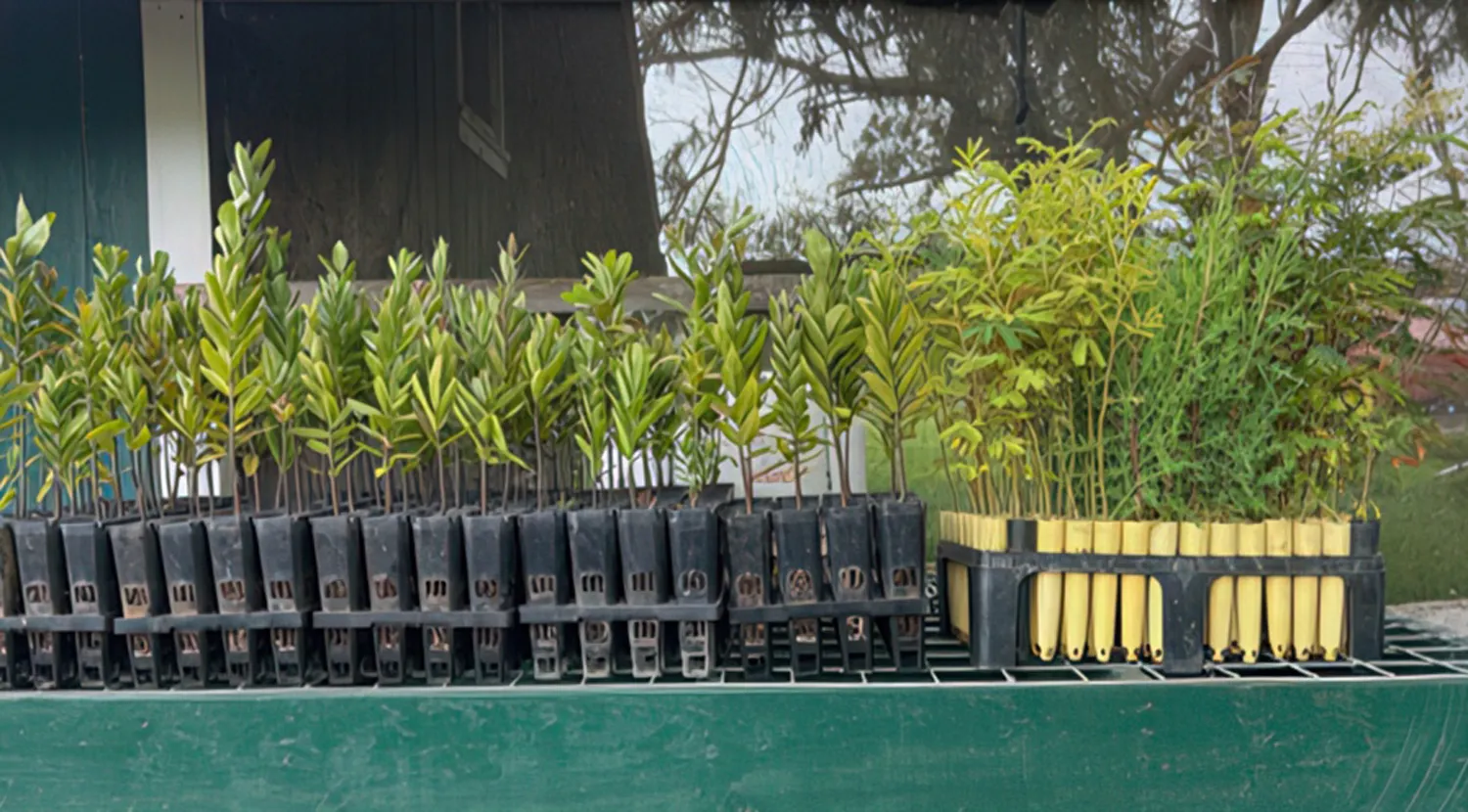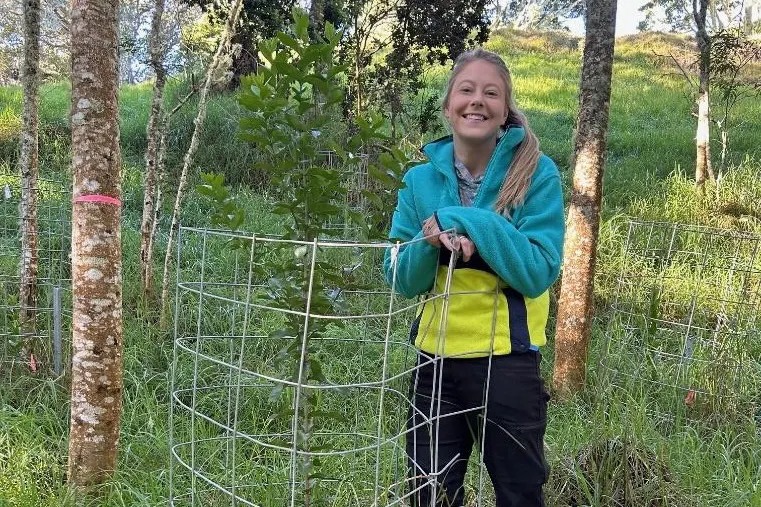Background / justification
With a lack of abundant seed sources and natural regeneration, ‘iliahi is currently facing severe restoration challenges that may be exacerbated in future climates. Importantly, due to ‘iliahi’s reliance on a host for additional water acquisition through root haustoria, increased incidence and severity of drought may have significant negative impacts on ‘iliahi performance and physiology compared to non-hemiparasitic tree species. However, ‘iliahi performance is likely largely dependent on the host’s ecophysiological responses to climate, as well as the environmental conditions the ‘iliahi are established in. The overall goal of my Ph.D. dissertation proposal is to improve our understanding of ‘iliahi and host-‘iliahi relationships under several planting scenarios, to help inform management strategies that maximize growth and survival while minimizing the potential for water stress.
Project 1 Objective
Objective 1: Understanding the influence of microenvironment on underplanted ‘iliahi seedling performance and water status.
- The goal of this objective is to determine a suite of optimal environmental conditions for ‘iliahi, that could be emulated in future ‘iliahi plantings.
Approach
- This project began in the summer of 2023 at Waipunalei (Parker Ranch), in an existing mature mixed forest comprised of primarily koa and ‘ōhi‘a. We underplanted 120 ‘iliahi seedlings under a gradient of canopy openness in created through multiple crop-tree release thinnings for selected canopy koa. Individual tree cages were installed to protect planted seedlings from feral ungulate browse damage trees (Figure 1).
- Canopy openness and stand basal area were measured at the time of planting.
- In the summer of 2024, we conducted detailed tree-level surveys of microenvironment providing data pertaining to: understory vegetation class cover, microtopography (slope and aspect), soil chemistry, distance to nearest host tree, and DBH of nearest host tree. Repeated instantaneous measurements of soil moisture are collected every 6 months, and will be averaged at tree-level to analyze water relations.
- All these environmental variables will be used to assess ‘iliahi performance (stem height, root collar diameter growth) as well as water status (pre-dawn and mid-day water potential, relative leaf water content, transpiration) and other key physiological parameters (chlorophyll content, photosynthesis) in relation to the microenvironment they are planted in.
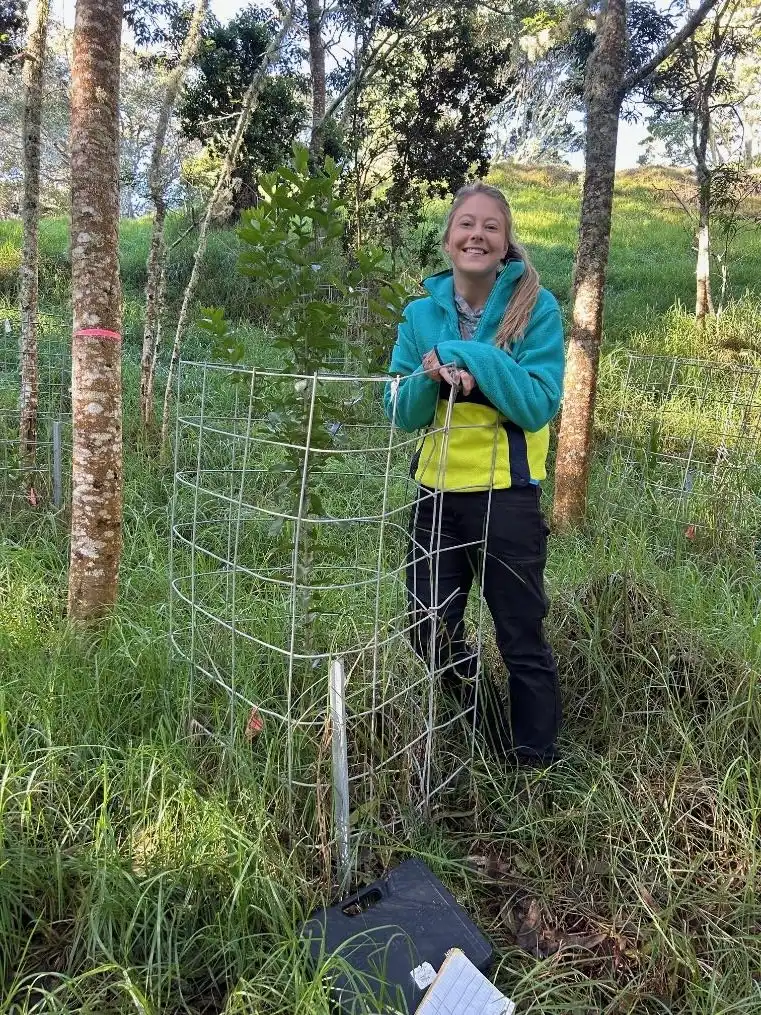
Preliminary results:
- Since project initiation, we have conducted 6-month repeated measurements for: tree height, diameter at root collar, and diameter. In the last 1.5 years post-outplanting, there is 100% survival for ‘iliahi seedlings, which are growing rapidly (Figure 2).
- On average, ‘iliahi seedlings have grown 81.8 cm in height, and 5.1 mm in diameter over 18 months of growth.
- As of August 2024, we have found a significant interaction effect of microtopography (aspect*slope), as well as average soil moisture on ‘iliahi height. Please note these results are preliminary and may change as data is collected through the end of this study in 2026.
- We have detected a negative effect of increased soil moisture on seedling height (Figure 3). As this site receives 2,000-2,500 mm of precipitation a year on average, this may indicate that excessive soil moisture in a non-moisture-limited system may have negative impacts on height growth.
- As of now, there is no significant effect of canopy openness on ‘iliahi height or diameter growth, indicating other variables in this particular environment may be more influential during early establishment.
- Average midday water potential in August 2024 for all ‘iliahi seedlings was -2.28 MPa (range -0.4 to -4.2, S.E.: 0.0634), which is noticeably lower than other tropical dry forest tree species including many Fabaceae species that may maintain midday water potential levels closer to -1.0 MPa when not stressed.
- Field measurements of surrounding koa at Waipuanlei ranged from -0.5 to -1.1 MPa.
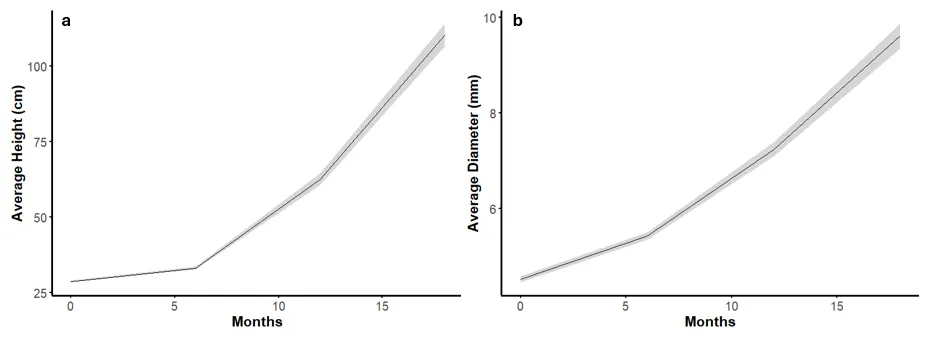
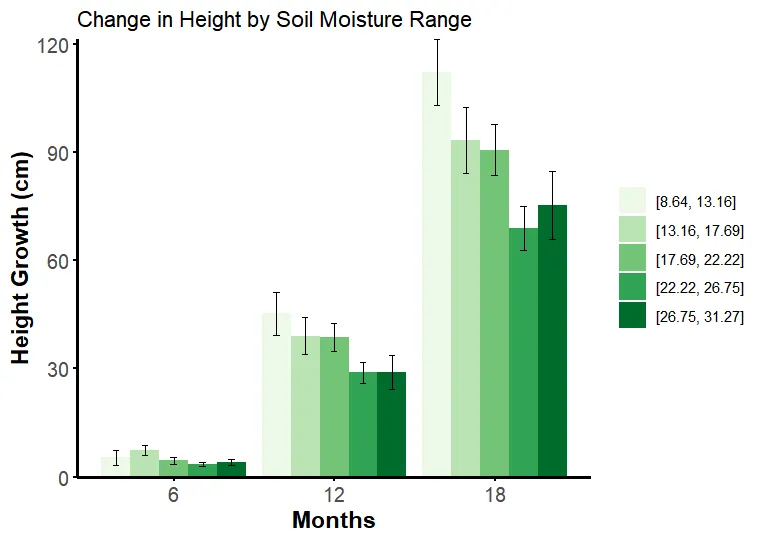
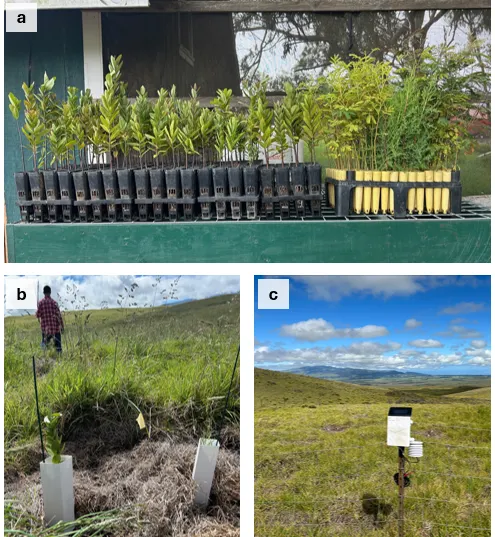
Project 2 Objective:
Objective 2: Improve our understanding of the interactive effects of planting site microclimate and host species on initial ‘iliahi performance.
- The goal of this objective is to determine which host is best suited for co-planting with ‘iliahi across the climate gradients, to inform future restoration planting strategies for non-forested areas.
Approach:
- Six plots spanning from 1490 – 1950 m in elevation were planted in May 2024 in Parker Ranch pastureland on Mauna Kea to initiate this study, using already established fenced exclosures.
- A total of 40 ‘iliahi were planted per plot, either alone (control) or with a host 0.5m away (host species: koa, koai’a, and Monterey cypress, Figure 4a). A boundary of a’ali’i were also planted to reduce edge effects. Each plot was a complete randomized design, with a minimum of 3m spacing between replicates.
- Milk cartons were installed with bamboo stakes for each planted seedling for wind and desiccation protection (Figure 4b).
- Initial height and diameter were recorded at the time of outplanting.
- Climate dataloggers are installed at each plot, continuously monitoring air temperature, relative humidity, soil temperature, and soil moisture content at 30-minute intervals (Figure 4c).
- In May 2025 we will collect seedling performance data: midday water potential, photosynthesis, stomatal conductance, chlorophyll fluorescence; as well as 1-year height and diameter measurements for both ‘iliahi and co-planted hosts. This will be repeated in early 2026 prior to final analysis.
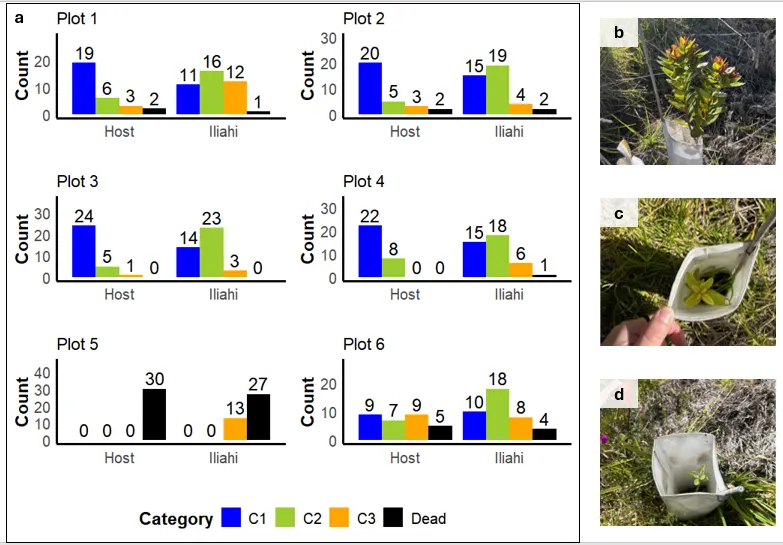
Preliminary results:
- At three months post-outplanting there was substantial initial defoliation for all ‘iliahi planted across the six plots, however resprouting was prolific at this time. Out of 240 ‘iliahi, only four had died by this time, and there was no host mortality.
- Across all six plots, there is a wide range in microclimatic conditions (soil water content, soil temperature, air temperature, and air humidity) with no apparent correlation between elevation and soil water content emerging at this time.
- Six months post-outplanting (February 2025) there was a range in ‘iliahi performance and conditions across all sites, however in five of six sites there was still limited mortality with only 8/200 trees succumbing to mortality (Figure 5). One plot experienced significant mortality (100% host death, 67.5% ‘iliahi death) likely due to wind exposure and poor soils due to a 2021 wildfire that burned this region.
Project 3 Objective:
Objective 3: Investigate the impact of water deficit on ‘iliahi when grown alone or co-established with a host.
- The goal of this objective is to determine how water deficit and the presence of a host impacts ‘iliahi water and carbon dynamics, to inform and interpret ‘iliahi field trials.
Approach:
- In 2023, we began growing multiple cohorts of ‘iliahi seedlings at the Purdue University greenhouses. After six months of growth, we sowed imbibed koa seeds directly into a subset of ‘iliahi pots to facilitate the formation of haustoria connections. Koa and ‘iliahi used for drought trials will be grown together for a minimum of six months.
- The final water stress study design will be a 2 x 2 factorial design: host/no host and well-watered/water stressed. A total of 40 pots will be planted (n=10 per treatment), with ‘iliahi and koa transplanted from D40s where they were grown, into larger 3-gallon nursery pots to simulate outplanting. Seedlings will be left to acclimate to new pots for three weeks to minimize transplant shock effects. Two ‘iliahi will be planted per pot for the no host treatment, to emulate and remove the confounding impact of increased water demand from the host koa.
- Once pots dry down to their water deficit threshold, a multi-week intensive physiological assessment of water potential, leaf relative water content, photosynthesis, stomatal conductance, and chlorophyll fluorescence will be conducted. Pots will be weighed daily and rewatered either to field capacity (well-watered treatment) or to the water deficit threshold.
Preliminary results:
- In December 2024/January 2025, a pilot dry-down trial was conducted to determine how long it takes ‘iliahi and ‘iliahi-koa pairs to dry from field capacity to an adequate water deficit level (e.g. 5% volumetric water content). For a 1:1 perlite to potting soil mix, it took approximately 6 weeks to dry the pots to 0% VWC. At this time, ‘iliahi were wilting but there was no mortality until approximately ~12 weeks without watering.
Future plans
During the spring of 2025, a pilot water deficit greenhouse trial will be conducted using a smaller number of replicates, to inform the final experiment which will be conducted in July of 2025. In May and August of 2025, 2-year measurements for the Waipunalei ‘iliahi underplanting trial and 1-year measurements for the host/microclimate suitability trial will be collected and analyzed.

